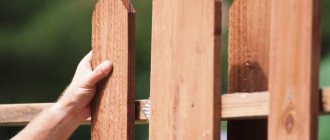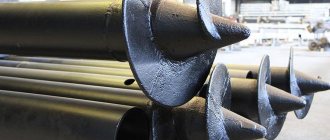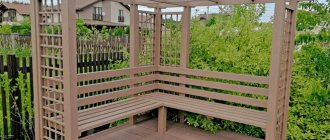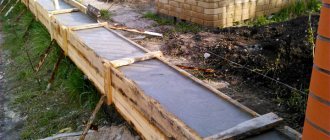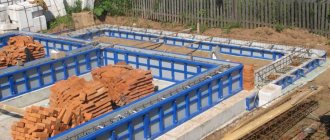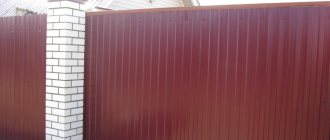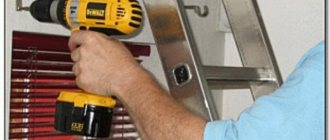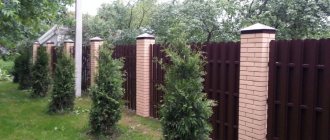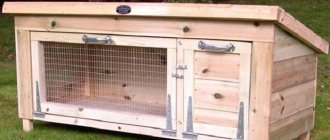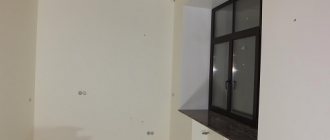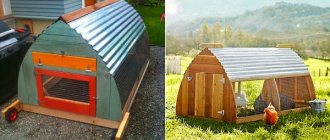The quality of the supports determines the service life and reliability of the entire fence. Wooden fence posts deserve special attention, namely the purchase of well-dried raw materials. Unlike metal supports, they require pre-treatment and periodic maintenance. But with proper use and compliance with the stages of the construction process, they can compete with any other material.
What are the advantages of wooden poles
Photo: logs pointed at one end.
Among the main ones there are:
- high strength, which means resistance to strong gusts of wind;
- low weight of material;
- ease of assembly and installation allows you to create a fence with your own hands, without outside help;
- service life, subject to periodic processing, is up to 30 years;
- environmentally friendly, natural raw materials;
- affordable price;
- good compatibility with brick, metal, corrugated board, stone, picket fence;
- aesthetic appearance;
- the ability to paint in any colors;
- no need for special equipment.
Photo: poles made of timber with embedded logs.
Among the shortcomings they note:
- susceptibility to rotting;
- the need to pre-treat with protective agents;
- strength is lower than that of metal or concrete pillars;
- likelihood of minor repairs;
- need for regular care.
If you neglect the recommendations for periodic maintenance, then the service life of wooden racks will be reduced to 5–7 years.
Pros and cons of wooden supports
Wooden poles are a popular solution for erecting fences around the perimeter of a house area and garden plot. This is due not only to the availability and low price of the material, but also to its other advantages. Wood supports have the following advantages:
- environmental Safety;
- aesthetic appeal (with high-quality surface treatment);
- durability (while protecting wood).
A wooden fence also has its disadvantages:
- exposure to environmental factors (drying out from exposure to high air temperatures, swelling due to waterlogging during the rainy season, darkening of untreated wood);
- insect damage;
- a small selection of materials that harmoniously combine with these supports.
If the spans are decided to be made of wood, wooden poles are the best choice. They look good in combination with metal profiles and mesh materials (chain-link mesh). They harmonize with concrete and brick. Installation of the fence takes little time.
Methods and means of protecting supports from moisture
The parts of the pillars in contact with the ground are most susceptible to destruction. The site will have constantly high humidity and an ideal environment for the development of rot and damage by insects, therefore, in addition to pre-treating all the wood with antiseptics, the bottom is coated in several layers with bitumen mastic and resin. For reliability, you can also wrap it in roofing felt.
Photo: places where wooden poles are treated with bitumen mastic
Of the insects, raw materials are most often affected by the house borer and weevil.
If you come across a superficially damaged log or beam, it can still be saved using special impregnations. Insect control solutions are toxic, so it is recommended to apply them in the fresh air and wear a protective mask and gloves.
Suitable:
- sodium fluoride;
- zinc chloride;
- creosote oils;
- copper sulfate;
- hexachlorane;
- chlorophos.
Popular:
- Polyex Woodpecker;
- Aquatex;
- Aqua-varnish Bor.
In the case when the raw material is damaged through and through, it is no longer possible to extend its service life, and it is unsuitable for construction.
To protect against moisture, it is better to impregnate the material with deep penetration solutions or those that create a durable film on the surface.
The first type is considered more effective. This includes:
- Belinka Interior Sauna;
- Pirilax;
- Aidol Langzeit-Lasur;
- Senezh Ecobio and other products.
Any commercial water-based preparations are not suitable for protecting fence posts.
Detailed information about other wood processing methods:
- How to coat a wooden fence for durability
- How to protect wood from moisture and rotting
Design Features
For wooden fence posts, dry, defect-free wood should be used. The best option is a solid tree, freed from bark. Chips, cracks and other imperfections in wood reduce the quality of supports. Of course, racks made of good-quality wood are more expensive, but it is better to give preference to high-quality products at a higher price, because with proper processing they can last up to 20 years.
Layout of supports in the ground
The long service life of wooden racks is facilitated by treating their base with antiseptics, bitumen, copper sulfate, and stain. In addition, waterproofing is used for the buried part of the installed pillars.
It is necessary to take into account the ratio of the thickness of the rack and the height of the fence. If the fence exceeds 1.5 m, the thickness of the post should not be less than 0.15x0.15 m.
Before placing the racks, they must be treated with protective compounds.
Timber is not the most suitable material for wooden supports. Racks made of timber wear out relatively quickly due to the openness of the fibers, which cannot be protected.
The wooden support should not come into contact with the ground. To make the wood less saturated with moisture, the thicker part of the rack should be left at the top.
It wouldn't hurt to repaint the pillars every year.
We periodically touch up the most vulnerable areas
Advantages:
- relatively inexpensive material cost;
- environmental cleanliness;
- attractive appearance;
- possibility of self-installation;
- the possibility of making wooden fence posts with your own hands.
Fences made of this material are in perfect harmony on the site
Flaws:
- exposure to humidity;
- shorter service life compared to other types of supports;
- the need for more frequent painting compared to metal racks;
- compatibility only with wooden fence fabric.
Support design diagram
How to make a wicker fence from boards, read the link.
Wood Post Installation Methods with Step-by-Step Guide
It is worth choosing the most suitable one after a thorough analysis of the type of soil, the climatic conditions of the region, the size of the fence and the future load on it.
There are the following methods:
- Concreting.
- Driving into the ground.
- Butting of supports.
Sometimes there is the option of installing bars inside a part of a metal pipe or steel cup tightly fixed in the soil.
We will consider the first three - the most popular and accessible.
Concreting
Tools you will need:
- Boer;
- roulette;
- pegs with rope;
- level;
- spacers;
- scrap;
- crushed stone (broken brick);
- concrete.
Photo: the 50x50 timber is concreted, it’s time to start installing the fence sections
. Work order:
- They make markings. You need to start it from the corner along the length of the section line. In these places, pegs are driven in, onto which the rope is pulled tightly. The recommended span width is from 2 to 3 m.
- Next, they begin drilling holes for supports. If you don't have a drill, you can use a regular shovel. The depth should be at least ⅓ of the height of the pillars. They will not stagger and be subject to swelling of the soil in frosty weather. Often this figure is 1-1.5 m. The width is 20 cm larger than the diameter of the support.
- But the bottom is filled with crushed stone and compacted.
- The bottom of the pillar is coated with mastic and wrapped with roofing felt.
- Now you need to try to install the beam. Verticality is checked with a level.
- Spacers are placed on the sides. If somewhere the height does not agree, add more crushed stone, pour water on it, and tamp it down.
- The remaining space is filled with concrete mortar.
Let the racks stand for up to 2 weeks. After that, the spacers can be removed and you can begin covering the fence sections.
Driving into the ground
It is considered a temporary but budget-friendly method of fixing supports. Not suitable for rocky, soft soils.
It is used in the construction of low fences on stable soil.
To make it easier to hammer the timber into the ground, the lower part is sharpened symmetrically to form a stake. A board of soft wood is placed on top to avoid damage to the upper part of the support. Vertical installation is checked with a level. If the tilt is incorrect, it is changed by side blows on the beam. The soil around the fixed support is carefully compacted.
Installation of pillars
In order to properly install the pole, it is important to ensure high-quality waterproofing of the part that will be immersed in the ground. Wooden supports that are not protected from contact with the soil will last 5-7 years and will break due to winds or other loads. The breaking point is always located either at ground level or at a small height from it.
Dig
The construction of fences provides several ways to install supports. The simplest and fastest is burying. The pit should be 20-30 cm deep than the freezing point of the soil in the construction region. This indicator is also taken into account when choosing the length of lumber. The bottom of the recess is leveled, a drainage “cushion” is made: 5-7 cm of sand and 10-15 cm of gravel. It is necessary to remove moisture from the soil adjacent to the support. Drainage will also compensate for soil movements during periods of freezing and thawing, and a fence with wooden supports will not move.
The pre-treated post is immersed in the hole and leveled vertically using a bubble level. If the work is performed without an assistant, the support will need to be fixed in this position. The problem is solved with the help of stones and jibs. Then backfill is performed: the hole is filled with the excavated soil and compacted.
Hammering
It is not often that a wooden post is hammered. This installation method is used when installing metal supports. They have higher compressive and bending strength and are resistant to mechanical stress. But if the soil is soft enough, the wood is strong and you have all the necessary tools (sledgehammer or headstock), you can hammer in a wood pole. It is advisable to have an assistant to perform this work.
A beam no more than 1.5 m long can be driven into the ground with a sledgehammer without much difficulty. For a support with a height of more than 1.5 m, a “grandmother” will be required. This is a self-made device from a piece of metal pipe with a weighted lower part. It is centered over the upper end of the pillar, lifted above it using levers and released. A series of such blows drives the pillar into the ground.
Zabutovka
Backfilling fence posts is a method that is in many ways similar to burying. You will need to dig a hole, form a drainage “cushion” and install a beam or log at the bottom. After which the pillar must be leveled, covering it with jibs on all sides. Backfilling involves backfilling with gravel or crushed stone. It is advisable to use stones of medium or small fraction. Crushed stone is poured into the hole to a height of 15-20 cm, spilled with water and compacted using a crowbar or a piece of timber. In this way, the pit is filled layer by layer to the ground level.
Using a metal pipe
A wooden fence with timber posts can be reinforced with metal pipes. This will prevent contact of wood with the ground, which will extend the life of the fence. The cross-section of the pipe should be 2-3 cm larger than the cross-section of the timber or the diameter of the log. The optimal metal thickness is 4-5 mm. The length of the pipe should be such that, immersed in the hole, it rises 20-30 cm above the ground level.
Installation of wooden fence posts using metal pipes provides two options for attaching timber (logs) to metal:
- attracting with clamps a wooden support raised above the ground level to a pipe dug into the ground from its outer side;
- attraction of beams immersed inside the pipe with pins.
Before starting installation work, we must not forget about the need to treat the metal with an anti-corrosion compound.
Concreting
Wooden fence posts can be installed by concreting. This is the most reliable installation method, but it must be done correctly. Simply filling a dug hole with concrete will not ensure reliable installation of the support. The cement-sand lump will hold the beam, but it (the lump) itself will be mobile in the soil, which is always softer than concrete.
In order to prevent vertical deflection of the support, reinforcement bars with a cross-section of at least 6 mm are driven into the walls of the pit. For greater reliability, you can make two tiers of these metal rods. Sequence of work:
- dig a hole;
- level its bottom;
- form a drainage “cushion”;
- drive reinforcement into the walls of the pit;
- install a pillar on the bottom;
- strengthen it with jibs;
- concrete is poured in layers, compacting it with a metal rod (they pierce the cement-sand mortar so that air comes out of it);
- cover fresh concrete with damp burlap or polyethylene.
Advantages of wooden fences and supports
Despite all the difficulties with processing and operation, poles and sections made of wood have a number of advantages over other materials:
- strength. A column thickness of 10 cm is enough to withstand even strong winds;
- the work does not require complex and expensive equipment. Sections or cross beams are attached using a standard screwdriver;
- with the right selection of companion materials, you can find a solution for a building in any style. The wood lends itself well to processing. Any shape can be cut out of it with your own hands, without lathes or milling machines;
- environmental Safety. Wood, even after treatment with septic tanks, is not a source of harmful volatile substances;
- low cost compared to metal, forging or brick.
Metal poles: strength and lightness
Photo of a green fence on metal posts
Fences on monolithic foundations, made of brick or concrete, are often equipped with metal supports. The service life of such products is over 50 years. The combination of reasonable price and reliability is one of their advantages.
The supports are made in production from profile or round pipes. An important factor when choosing a material is the thickness of the metal (at least 2 mm). The diameter also affects durability - the larger it is, the better.
Before hammering / digging in the supports, they must be treated with an anti-corrosion compound. To protect against precipitation, metal caps are put on top.
Square and rectangular supports are usually used to frame gates. Round options are optimal for fastening the canvas.
| № | Advantages | № | Flaws |
| 1. | Strength and Durability | 1. | Poor tolerance to high humidity (needs treatment) |
| 2. | Increased structural rigidity | 2. | Difficulty in transportation |
| 3. | Ability to withstand heavy loads |
How to make wooden fence posts
The type of wood used in the manufacture of wooden posts for the construction of the fence is of no small importance The most reliable and durable are fence posts made of oak. You can also use wood species such as beech, hazel, birch, and larch. Coniferous and fruit-bearing trees are not used, since coniferous trees are soft and dry quickly, and fruit-bearing trees have a soft core.
For the fence, you can make decorative posts, as well as posts with threads, which must be treated with special antiseptic agents.
Recent Entries
Chainsaw or electric saw - what to choose for the garden? 4 mistakes when growing tomatoes in pots that almost all housewives make Secrets of growing seedlings from the Japanese, who are very sensitive to the soil
How to treat wooden posts before burying them in the ground
Coating with antiseptics alone is not enough to protect the underground part of the pillar. It must be treated with waterproofing compounds. Suitable for this:
- Liquid molten bitumen;
- Polymer special coating mastic;
- Tar;
- Technical development.
To waterproof the underground part of the pillar, liquid coating is needed. It fits tightly to the material and creates reliable protection. Roll wraps are ineffective in this case.
Fence base - pillars
Whatever material the fence is designed from, general requirements are imposed on its supports:
- Mechanical strength.
- Resistance to aggressive environmental influences.
- Reliability.
- Ability to withstand wind loads.
- Convenience and ease of installation.
- Durability.
An important aspect is also the compatibility of materials of racks and panels and, of course, the final price of the structure. The most budget-friendly option for fence posts is, of course, wooden fence posts, which we will talk about.
Products stored in this way will have an ideal geometry
Installation of wooden fence supports
The first stage in the construction of wooden fences is the installation of wooden fence posts. Of course, before starting such an action, you need to find out how to install them and how to do it correctly, without errors.
Fencing equipment diagram
A two-meter fence requires supports with a cross-sectional size of 9–10 cm. If the fence is taller than two meters, then concreting is necessary for its supports. In this case, the size of their cross-section increases proportionally.
